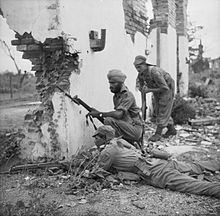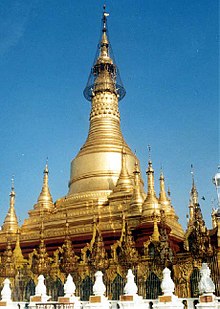Pyay
Pyay
ပြည်မြို့ ဍုၚ်ပြန် Prome | |
|---|---|
City | |
 Shwesandaw Pagodain Pyay | |
| Coordinates:18°49′12″N95°12′56″E/ 18.82000°N 95.21556°E | |
| Country | |
| Division | |
| District | Pyay District |
| Township | Pyay Township |
| Population (2014) | |
| •Urban | 134,861 |
| •Metro | 251,643 |
| Time zone | UTC+6:30(+6:30) |
Pyay(Burmese:ပြည်မြို့;MLCTS:prany mrui.,pronounced[pjìmjo̰];Mon:ပြန်Mon pronunciation:[prɔn],Burmese pronunciation:[pjàɰ̃];also known asPromeandPyè) is the principal town ofPyay Townshipin theBago RegioninMyanmar.Pyay is located on the bank of theIrrawaddy River,260 km (160 mi) north-west ofYangon.[1]It is an important trade center for the Ayeyarwady Delta, Central and Upper Myanmar and the Rakhine (Arakan) State.[2]The BritishIrrawaddy Flotilla Companyestablished the current town in the late 19th century on the Irrawaddy as a transshipment point for cargo betweenUpperandLower Burma.The English novelistJane Austen's brother Rear AdmiralCharles Austendied here in 1852.
The district of Pyay encompasses the valley of the Irrawaddy, located betweenThayet,HinthadaandTharrawaddydistricts. Along the western side of Pyay District are theArakan Mountainsand along the eastern side are thePegu Range.Pyay District's main towns are Pyay,Shwetaung,andPaungde.
Etymology
[edit]The name "Pyay" means "country" inBurmese,and refers to the ruins of the main city of thePyu city-states,Sri Ksetra(Burmese:သရေခေတ္တရာ,SanskritŚrīkṣetra"blessed place, country" ), which is located 8 km (5.0 mi) to the south-east of modern Pyay and is in the village of Hmawa.
Geography
[edit]The north and north-east of the district is forest-covered, and contains numerous valleys and ravines, which unite in one large stream called theNawengRiver. The most important of the plains lie in the south and south-west portions of Pyay, and extend along the whole length of the railway that runs between. There are, in addition large tracts of land covered by jungle, which are available for cultivation. The principal river is the Irrawaddy, which intersects the district from north to south; next in importance are theThaniand its tributaries and the Naweng system of rivers. In the hills near the capital the soil is of Tertiary formation, and in the plains it is an alluvial deposit.
History
[edit]Much debate surrounds the construction of Sri Ksetra.Htin Aungsuggests that Pyu might have been founded in 78 CE, based on the Sanskrit / Pyu Era.D. G. E. HallandGordon Luce,however, claim that civilisation of the Irrawaddy Valley could not have been possible before the 4th century, thus, attributing the founding of Sri Ksetra to 638, from which the current Burmese Kawza Era begins.
Sri Ksetra was the capital of the Pyu dynasty of Vikrama. The city was circular with walls enclosing about 46 km2(18 sq mi), making it the largest walled city in Southeast Asia during its peak. The city contained both housing and farms, as is evident from the remains of waterways and tanks which have been discovered.
The Chinese pilgrimsXuanzangandYijingmentioned Sri Ksetra in their mid-7th-century accounts.[3]It is not known when precisely the Pyu abandoned Sri Ksetra and moved northward. It is speculated that their decline was due to the growth of the Irrawaddy river delta, cutting it off from coastal trade, and also from Mon and later Tai Shan incursions. Burmese chronicles state that when Anawrahta invaded the southern parts of modern-day Myanmar in 1057, he ordered the ruins of Sri Ksetra to be destroyed to prevent rebels from sheltering there. The Burmese came to call the old Pyu center Pyi. The extensive ruins have been the subject of intensive archaeological investigation.

Called Prome by the British (after the name that appears in the Portuguese texts of the 17th century), the city became part of British territory after theSecond Anglo-Burmese Warin 1853. The town was taken by the British in 1825 during theBattle of Promeand again in 1852, on both occasions with hardly any opposition. In 1862, it was almost entirely destroyed by fire, and was afterwards relaid out in straight and broad streets. It was erected into a municipality in 1874, and since then great improvements have been made, including waterworks.

During World War II the city was the site of theBattle of Prome.The city was later retaken by the British Army in May 1945.
Climate
[edit]Pyay has atropical savanna climate(Köppen climate classificationAw). Temperatures are hot throughout the year, especially in the months before the monsoon from March to May when average maximum temperatures exceed 36 °C or 96.8 °F. The winter months from December to February are somewhat milder than the rest of the year. There is a winter dry season from December to April and a summer wet season from May to November, although rainfall during this wet season is much less extreme than in coastal cities likeYangonor especiallySittwe.
| Climate data for Pyay (1991–2020) | |||||||||||||
|---|---|---|---|---|---|---|---|---|---|---|---|---|---|
| Month | Jan | Feb | Mar | Apr | May | Jun | Jul | Aug | Sep | Oct | Nov | Dec | Year |
| Mean daily maximum °C (°F) | 32.6 (90.7) |
35.5 (95.9) |
37.9 (100.2) |
38.9 (102.0) |
36.1 (97.0) |
32.3 (90.1) |
31.3 (88.3) |
31.4 (88.5) |
32.7 (90.9) |
33.6 (92.5) |
33.3 (91.9) |
31.9 (89.4) |
33.9 (93.0) |
| Daily mean °C (°F) | 24.4 (75.9) |
26.6 (79.9) |
29.5 (85.1) |
31.8 (89.2) |
30.8 (87.4) |
28.5 (83.3) |
27.9 (82.2) |
27.9 (82.2) |
28.5 (83.3) |
28.8 (83.8) |
27.5 (81.5) |
25.1 (77.2) |
28.1 (82.6) |
| Mean daily minimum °C (°F) | 16.3 (61.3) |
17.7 (63.9) |
21.2 (70.2) |
24.6 (76.3) |
25.5 (77.9) |
24.7 (76.5) |
24.5 (76.1) |
24.5 (76.1) |
24.4 (75.9) |
24.1 (75.4) |
21.7 (71.1) |
18.2 (64.8) |
22.3 (72.1) |
| Averageprecipitationmm (inches) | 4.3 (0.17) |
0.7 (0.03) |
4.9 (0.19) |
36.5 (1.44) |
145.9 (5.74) |
260 (10.2) |
218.5 (8.60) |
232.8 (9.17) |
219.1 (8.63) |
130.8 (5.15) |
30.2 (1.19) |
4.1 (0.16) |
1,287.8 (50.70) |
| Average precipitation days(≥ 1.0 mm) | 0.4 | 0.1 | 0.7 | 2.1 | 9.6 | 18.9 | 19.8 | 19.7 | 15.8 | 10.1 | 2.7 | 0.4 | 100.3 |
| Source:World Meteorological Organization[4] | |||||||||||||
Economy
[edit]
The main crop isrice,but some cotton and tobacco are grown, while the custard apples are famous.Sericultureis extensively carried on by a special class. The forests yieldteakandcutch,cotton and silk-weaving are important industries; there are also manufactures of ornamental boxes, coarsebrown sugarand cutch.
Culture
[edit]
For a town of its size, Pyay is well-renowned for a number of local delicacies.[5]It is reputed for thePyaypalata (ပြည်ပလာတာ), consisting ofparatha,Burmese chicken and potato curry,and raw onions.[6]It is also known for a number ofBurmese salads,including thePyayrice salad (ပြည်ထမင်းသုပ်) andPyayassorted salad (ပြည်အသုပ်စုံ).[5][7]
Pyay also produces a local pickled delicacy calledtaw laphet(တောလက်ဖက်;lit. 'rurallaphet') orNibbindalaphet(နိဗ္ဗိန္ဒလက်ဖက်).[8]Originating fromBurmese nunneriesin the hills surrounding Pyay, thelaphetis fermented from the leaves of thenaywe(နရွဲ) tree, orkyettet(ကြက်တက်), theCombretum pilosumplant.[9][10]The pulp is then tightly wrapped into driedbanbwe(ဘန့်ပွေး) leaves and left soaking in regularly changed water for up to 2 years, before it is consumed.[9]Taw laphetis otherwise consumed in an identical fashion to traditional laphet.[9]
Tourism
[edit]
To the south and south-east, the town is closed in by low pagoda-topped hills, on one of which stands the conspicuous gildedShwesandaw Pagoda.The Shwesandaw Pagoda is a notableBuddhist pagodain the center of Pyay. It is the terminus for a railway from Yangon, which runs through the district.[11]
To the west of Pyay, crossingIrrawaddy riverthrough Nawaday bridge, stands the Shwebontha Muni Pagoda. The Buddha statue is one of three replica of theMaha Myat MuniBuddha statue, believed to date back 554 B.C. when the king Sandar Thuriya ruled.[12]
Education
[edit]Pyay City has three universities. The universities are Pyay University (PU),Pyay Technological University(PTU), andComputer University, Pyay.Pyay University is situated near to the town centre of Pyay. PTU, which is one of the best ranking University in Myanmar, is situated near to Hnawgone village and Latkhoukpin village, a few miles away from Pyay. CU, Pyay is also quite a far distance from downtown.
Health care
[edit]- Pyay General Hospital
- Aung Zaw Oo Hospital
- Myo Thuka Hospital
- Aung Tharaphu Hospital
- Lawkaparla Hospital
- Pyi Myanmar Hospital
Notable people
[edit]- Khin One(1947—2000), Burmese painter, writer, and singer
References
[edit]- ^Pyay. (2005). In The Hutchinson Unabridged Encyclopedia including Atlas. Retrieved March 13, 2008, fromhttp:// credoreference /entry/6458618
- ^"Myanmar Travel Information".Archivedfrom the original on 2020-02-25.Retrieved2019-02-26.
- ^Cœdès 1968,pp. 62–63, 77.
- ^"World Meteorological Organization Climate Normals for 1991–2020".World Meteorological Organization.Retrieved16 October2023.
- ^ab"ပြည် အစားအစာတွေ ရနိုင်တဲ့ ဗိုလ်အောင်ကျော်လမ်းက ဆိုင်သစ်လေး".The Myanmar Times(in Burmese). 2017-06-28.Archivedfrom the original on 2021-01-14.Retrieved2021-01-12.
- ^"ပြည်ပလာတာ".Danuphyu Daw Saw Yee (London).2012-03-17.Archivedfrom the original on 2012-04-01.Retrieved2021-01-09.
- ^"မနက်စောစောအတွက်အဆင်ပြေတဲ့ ပြည်ထမင်းသုပ်".The Irrawaddy(in Burmese).Archivedfrom the original on 2021-01-14.Retrieved2021-01-12.
- ^"ပြည်လက်ဆောင်".Ksetra Pyay(in Burmese).Archivedfrom the original on 2021-01-13.Retrieved2021-01-12.
- ^abc"ပြည်မြို့က တောလက်ဖက်".လွမ်းမပြေ သုတရပ်ဝန်(in Burmese). 2014-07-24.Retrieved2021-01-12.
- ^"ပြည်မြို့ကတောလက်ဖက်ကို နှီးနဲ့ဘာဖြစ်လို့တင်းနေအောင်ချည်ထားကြတာလဲ".MRTV Travelogue (Travel Diary -5.1)(in Burmese).Archivedfrom the original on 2021-01-19.Retrieved2021-01-12.
- ^Bagan: Shwesandaw Pagoda, Myanmar(Burma)Archived2008-05-17 at theWayback Machine
- ^"Shwe Bontha Muni Pagoda".Archivedfrom the original on 2019-02-27.Retrieved2019-02-27.
Bibliography
[edit]- Cœdès, George(1968).The Indianized States of South-East Asia.University of Hawaii Press.ISBN978-0-8248-0368-1.
- Htin Aung(1967).A History of Burma.Columbia University Press, 1967.
- Htin Aung;Asoka Society (1970).Burmese history before 1287: a defence of the chronicles.the Asoka Society.ISBN9780718921149.
- Stargardt, Janice (1 January 1990).The Ancient Pyu of Burma: Early Pyu cities in a man-made landscape.PACSEA.ISBN978-1-873178-00-3.
- Thant Myint-U(2011).The River of Lost Footsteps.Faber & Faber.ISBN978-0-571-26606-7.



